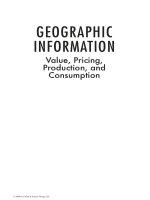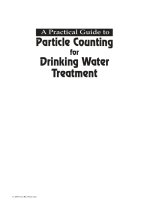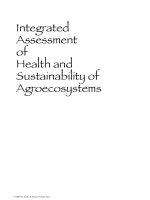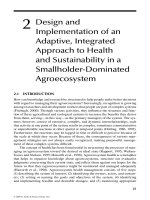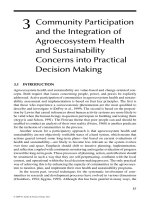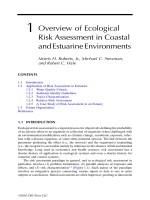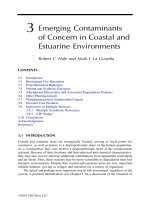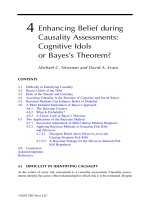Coastal and Estuarine Risk Assessment - Chapter 1 potx
Bạn đang xem bản rút gọn của tài liệu. Xem và tải ngay bản đầy đủ của tài liệu tại đây (154.39 KB, 13 trang )
©2002 CRC Press LLC
Overview of Ecological
Risk Assessment in Coastal
and Estuarine Environments
Morris H. Roberts, Jr., Michael C. Newman,
and Robert C. Hale
CONTENTS
1.1 Introduction
1.2 Application of Risk Assessment in Estuaries
1.2.1 Water Quality Criteria
1.2.2 Sediment Quality Guidelines
1.2.3 Toxics Characterization
1.2.4 Relative Risk Assessment
1.2.5 A Case Study of Risk Assessment in an Estuary
1.3 Forum Organization
References
1.1 INTRODUCTION
Ecological risk assessment is a logical process for objectively defining the probability
of an adverse effect to an organism or collection of organisms when challenged with
an environmental modification such as climatic change, xenobiotic exposure, infec-
tion with a disease organism, or some other potential stressor. The link between the
parameter producing the effect (i.e., the stressor) and the organism(s) responding
(i.e., the receptor) is accessible mainly by inference in the absence of full and detailed
knowledge. Long used in economics and health sciences, risk assessment has a
shorter history of application to ecological systems and even a shorter history for
estuarine and coastal systems.
The risk assessment paradigm in general, and in ecological risk assessment in
particular, involves (1) problem formulation, (2) parallel analyses of exposure and
effects, and (3) risk characterization
1–5
(Figure 1.1). Each aspect of the paradigm
involves an integrative process connecting various inputs or data to one or more
outputs or conclusions. Initial assessments are often imprecise, pointing to data needs
1
©2002 CRC Press LLC
that, if fulfilled, allow more rigorous assessments of risk with improved certainty in
the evaluation. Problem definition includes a determination of a valued resource
such as a population of commercially important species or keystone species, or
FIGURE 1.1
The environmental risk assessment paradigm as presented by the U.S. EPA.
Information inputs are shown in boxes, processes in ovals, and outputs in circles. (Modified
from Reference 5.)
©2002 CRC Press LLC
community structure. In this step, one determines what assessment end point(s) will
be used, develops a conceptual model that links the end point(s) to exposure, and
an analysis plan that incorporates both the end point(s) and the model.
The analysis phase involves collection of data on exposure, effects, and charac-
teristics of the ecosystem of interest. In coastal and estuarine situations, these
parameters are particularly dynamic and the resultant gradients in salinity and other
variables present special challenges to risk assessment. The analyses of exposure
and ecological responses occur in parallel, leading to exposure and response profiles.
Attention must be paid to environmental conditions in both analyses if the ultimate
risk estimation is to be credible.
The final stage in the process is risk characterization, resulting ultimately in a
risk estimate. To the extent possible, this characterization should be a quantitative
probability statement, but this is not always achievable in complex and dynamic
systems. As depicted in Figure 1.1, the risk characterization may be deemed inade-
quate, resulting in the need for additional data, reanalysis, and monitoring of the
outcome for plausibility.
Risk assessment is a practical management tool rather than a purely scientific
endeavor. It is useful for predicting the outcomes of activities such as chemical
use or disposal, or species introductions, or for attributing observed effects to
potential causes in a retrospective analysis. Risk assessment can generate enough
understanding to allow informed decision making relative to choosing among
several remedial actions. It is an especially important tool if the resources needed
to reduce risk are limited, if competing options exist, or if the relative value of
each action is not obvious.
This edited volume was developed to focus primarily on chemical exposure,
effect measurement, and risk characterization in estuarine and coastal environments.
The chemicals of concern are those that are or may become toxic in these environ-
ments. This focus is important not only because of intense historical uses, but also
because human use of the estuarine and coastal system continues to expand rapidly.
Historical human use has resulted in relic accumulations of chemical contaminants
in localized areas, and present human activities in coastal areas produces continued
introductions of chemical contaminants either directly (e.g., from discharge pipes)
or indirectly (e.g., polycyclic aromatic hydrocarbon, or PAH, from atmospheric
deposition as a result of vehicular emissions). Enhancing the importance of risk
assessment in estuaries is the current rapid migration of people into the coastal zone.
6
For example, the Chesapeake Bay watershed had a 19.3% increase in population
between 1970 and 1990. Smaller coastal watersheds such as St. Johns River (Flor-
ida), Tampa Bay (Florida), and San Diego Bay (California) had even larger popu-
lation increases of 43 to 47%.
7
With this population growth, the potential for sub-
stantial increases in adverse impacts on estuarine and coastal environments is
dramatically enhanced. Conversely, as these populations grow, the resources in
estuaries and coastal systems that serve as an inducement to human immigration are
among those most likely to deteriorate as a result of human activity.
Despite the focus on chemicals as the stressors of interest in most of this volume,
one must recognize that ecological risk assessment is a tool with broader application,
providing an objective approach to evaluate simultaneously the effects not only of
©2002 CRC Press LLC
chemical stressors, but also other stressors such as habitat loss (e.g., submerged
aquatic vegetation, salt marshes, or shoreline green ways), fishing pressure, or
reduced freshwater inputs (resulting from reservoir construction). This is reflected
in two recurrent themes in the book, i.e., the need to apply a landscape context for
assessment and the need to relate effects to stressors across all levels of ecological
organization from bacteria and primary producers to top carnivores, and from indi-
vidual organisms to communities.
Estuarine and coastal systems develop at the interface between land, fresh water,
and the oceans. As such, they are characterized by gradients, most obviously a
persistent salinity gradient. These systems are also physically dynamic over a variety
of timescales. Tidal cycles modify mixing regimes over different, but predictable,
periods in many coastal areas; wind varies aperiodically and interacts with tide to
further modify the flow of water and associated materials. Seasonal changes in air
temperature and precipitation are reflected in annual changes in temperature and
salinity of the water. As a result, these systems must be looked at in an ecotonal
context, as a habitat in which there are unique groups of organisms, as well as those
from freshwater or euhaline systems that have sufficient physiological tolerances to
handle conditions within these mixing zones and that utilize estuaries as sources of
food or as refuges from predators. Biological communities are dynamic and often
ephemeral during the year although recurrent over cycles of years.
These variable conditions affect both stressor and receptor. For there to be an
impact, there must be co-occurrence of the stressor and receptor. The degree of
exposure must be sufficient in intensity and duration to produce an effect. In less
dynamic systems, the presumption of stressor and receptor co-occurrence is often
reasonable over relatively long timescales. And equally important as a presumption,
the receptors must remain within the volume influenced by the stressor. Some species
inhabiting estuaries are highly mobile, and can move outside the region where a
stressor occurs. Other species may have evolved behavioral mechanisms to cope
with the natural variability of the system by isolating themselves from a stressor
until the stressor intensity has decreased; e.g., bivalves can close their shells, and
some organisms can encase themselves in mucus or another protective agent. Many
organisms have enzymatic mechanisms that allow them to detoxify chemicals, mech-
anisms that are induced by the presence of the chemical.
The tools of risk assessment have been developed for optimal use in less dynamic
systems. Therefore, the various steps in ecological risk assessment may need to be
modified to address dynamic estuarine and coastal conditions effectively. Is proper
consideration given to the effects of estuarine conditions on exposure concentrations
during assessments of exposure? Specifically, is sufficient attention given to the
effects of salinity, binding to sediment-associated or dissolved organic material, and
isolation in water masses by density gradients? Is the temporal and spatial sampling
utilized appropriate to the temporal and scalar variation in these dynamic systems?
Is the ecosystem context inherent in framing most risk assessments adequate for
coastal and estuarine systems that are physical boundaries and ecotones receiving
large amounts of materials, energy, and species from outside of the system for which
risk is to be estimated? Does the evaluation consider adequately all ecological
components including primary producers, secondary consumers, and saprophytes?
©2002 CRC Press LLC
In assessing hazard, is sufficient consideration given to variability in degree of
exposure or in rates of stressor input? Does the approach consider the inherent
seasonal variations in the presence of a species, reproductive activity, and growth?
Some of these issues are not unique to estuarine and coastal systems, and obviously
have persistent and collective implications about the validity of any risk assessment.
Nevertheless, the implications of the estuarine environment on risk assessment need
careful consideration.
1.2 APPLICATION OF RISK ASSESSMENT IN ESTUARIES
Although the use of ecological risk assessment in aquatic, and especially estuarine,
systems is a relatively new development, exposure and hazard evaluations have been
used in these systems for some time. These evaluations have been applied in setting
water quality criteria and standards, definition of sediment quality guidelines, char-
acterization of various segments of the estuaries with regard to toxicological effects,
and the so-called relative risk assessment. In each of these cases, frequent mention
is made of managing “risk” or the process being “risk-based,” yet many times no
actual determination of risk probabilities is conducted.
1.2.1 W
ATER
Q
UALITY
C
RITERIA
Water quality criteria are primarily based on laboratory exposure and effects data.
In collecting exposure and effects data, standard test designs require high consistency
of exposure over time and effects are monitored over timescales of days to months.
The intent is to achieve reproducible and precise data, even though these controlled
conditions may not accurately reflect field scenarios. From the laboratory data
developed for an array of species, a statistical estimate is made of the concentration
of a material that will be protective of the “most sensitive species.” Account is taken
of the interaction between a limited number of environmental variables (hardness,
acidity, or salinity) and the chemical of concern by modeling the relationships, again
assuming time constancy in all these parameters. A safety factor is then applied to
account for environmental variability and uncertainty.
8
Data for freshwater and saltwater species can be treated separately in this type
of analysis, leading to distinct water quality criteria for fresh water and salt water.
The derivation of distinct freshwater and saltwater criteria is clearly important for
many inorganic and organic materials that exhibit different bioavailabilities in these
two media. Examples include chlorine and cadmium,
9,10
but there are many others.
The analysis of exposure and effects data yields a concentration that notionally
should not be exceeded in a specific aqueous medium if the specified acute or chronic
effect is to be avoided. This process is a valuable first estimate of the hazard
concentration, but is not a risk assessment as defined herein, even though both
exposure and effect information are central to any environmental risk assessment.
The risk of adverse impact cannot be determined from the criteria.
The same effects data can be used to conduct a risk assessment as demonstrated
by Hall and his colleagues.
11
In the problem formulation, they selected two specific
chemicals, copper and cadmium, based on use patterns in Maryland waters. They
©2002 CRC Press LLC
then applied the broadest array of laboratory toxicity data available to determine the
concentration of each of these metals that affected the most sensitive 10th percentile
of species, thus defining a concentration protective of 90% of the species. If one
desired a more protective concentration, one could derive that from the same data.
This value is conceptually the same as the criterion value derived by the U.S.
Environmental Protection Agency (U.S. EPA), but obtained in a way that involves
all data. Measured concentrations in samples from specific locations can then be
compared with the concentration that produces a specified degree of protection. The
concentrations may also be compared with the effect curve to estimate the probability
of an adverse effect at specific locations as a result of exposure to the specific
compound for which the analysis was performed.
The issue of multiple stressors including effects of unidentified stressors was
not addressed in this example although the authors noted the concurrence of both
stressors in some locations. Hall et al.
11
discussed the strong preponderance of fish
and benthos information in the available data set and the paucity of plant and
zooplankton data. The importance of this observation cannot be assessed objectively
at this point, but if these groups are more sensitive than fish or benthos, the analysis
is clearly biased by the omission of such information. This observation points to a
definite need to expand the array of organisms routinely used for effects evaluations
to be more inclusive of important ecological components.
1.2.2 S
EDIMENT
Q
UALITY
G
UIDELINES
A variety of sediment quality guidelines (SQG) have been proposed in the past two
decades.
12–17
Different guidelines yield different answers about the concentration
that may be protective. All guidelines are based on exposure and effects data, and
some incorporate both laboratory and field data. Clearly, many geochemical param-
eters can affect bioavailability and will vary from place to place. The statistically
derived values are considered guidelines rather than criteria because spatial variabil-
ity in underlying conditions at any specific location may be different from those
embodied in the data from which the guidelines were derived. Despite the impreci-
sion of these guidelines, if carefully applied, these values can be useful to managers
faced with decisions involving sediment quality issues. Exceeding guidelines is
prima facie
evidence of a risk of sediment quality reduction and an attendant
substantial, if not quantified, risk of adverse effects.
With further manipulation, these guidelines can also provide a basis for estab-
lishing remediation criteria. Based on a sediment quotient value (SQV) (i.e., the
sum of the quotient between a measured value and the appropriate SQG for each
contaminant of concern), one can identify one or more levels of exposure that will,
with some degree of confidence, reduce adverse effects below a selected level(s).
18,19
The ratios identified at one site may then be cautiously applied as cleanup goals in
other locations. The approach has been used recently by the Army Corps of Engineers
in a feasibility study of sediment remediation in the Elizabeth River, Virginia.
20
A risk analysis approach in this application analogous to that used for water
would be a valuable endeavor. The use of guidelines does not allow an estimation
of risk probability. At present, the risk of an adverse effect resulting from exceeding
©2002 CRC Press LLC
a guideline such as an effects range median (ERM) is undefined. If the concentration
was two or more times above the ERM, the increase in risk is at present indetermi-
nate. An analysis that includes all available data to estimate risk would provide
valuable extensions to the present approaches.
Just as in the previous example related to water column impacts, risk analysis
for sediments as portrayed here would be accomplished one material at a time. In
reality, simultaneous exposure to multiple materials and other potential stressors is
typical. Better tools are needed to deal with this complexity.
1.2.3 T
OXICS
C
HARACTERIZATION
The sediment quality triad method is one approach used to characterize the impact
of chemical contaminants in estuaries. It was developed originally for Puget
Sound
12,21
and subsequently applied in San Francisco Bay
13
and elsewhere. In this
method, there is synoptic determination of chemical contaminants in the sediment,
measurement of toxic end points in laboratory tests of the sediment, and an assess-
ment of the benthic community. To understand bioavailability of chemicals in the
sediment, total organic carbon, acid-volatile sulfides, and other geochemical param-
eters are measured on sediment samples. From these three types of measures, one
can assess the health of a system on empirical grounds. The power of this approach
lies in the contemporaneous nature of the measurements.
The U.S. EPA Chesapeake Bay Program has, for a decade or more, been working
on a toxics characterization of various strata within the bay and its tributaries. The
program has been concerned with both water column and sedimentary effects. The
method for characterizing these strata as a region of concern, region of emphasis,
region with low probability for adverse effect, or region of insufficient or inconclu-
sive data has been described in detail.
22
The characterizations are based on available
ambient chemical concentration data for water, sediment, and finfish/shellfish tissue
and on effects information such as laboratory toxicity data for ambient water and
sediment samples and indices of biological integrity for benthic invertebrates. Data
collected under the auspices of the U.S. EPA Chesapeake Bay Program Office
23–30
with contemporaneous data collection were used along with other available, although
noncontemporaneous, data of certifiable high quality.
These determinations are risk based in that strata are ranked based on an estimate
of adverse effect by a panel of experts using professional judgment to assess the likeli-
hood of adverse impacts. This approach can resolve “regions of concern” from “regions
of no probable effect,” but does not allow objective evaluations of greater resolution.
These characterizations have nevertheless proved useful in prioritizing specific
regions for cleanup and in identifying the need for additional data in regions that
cannot currently be characterized. However, these characterizations alone do not
provide a clear strategy for the remediation of specific regions. Once a strategy has
been developed, quantitative cleanup goals must be established. Again, the charac-
terizations do not provide objective criteria for cleanup. Finally, if resolution among
regions is imprecise using this approach, one must conclude that there is insufficient
resolution to recognize the benefits derived from various cleanup options. Thus, the
use of these characterizations to guide management decisions is limited.
©2002 CRC Press LLC
An alternative approach to characterize strata, developed and used by Ian
Hartwell in Maryland, involves a risk-ranking approach based on ambient toxicity
results using a standard battery of water column and benthic tests, and some measure
of community health.
31–33
A score is calculated for each sample site based on severity
of effect, degree of response, variability of each test, consistency among various
effects measures, and number of effects measured. This approach allows one to
compare objectively data from multiple sites even if there were differences in
parameters measured, number of effects studied, and species tested.
In the sediment triad method, laboratory and field effects data are not always
consistent with one another. This inconsistency may be due to test conditions
modifying bioavailability, or a parameter other than toxicity producing an adverse
effect on communities. Further, the sediment triad method deals only with the
benthic component of the ecosystem. The risk-ranking method of Hartwell is an
imperfect, but nevertheless useful, way to address some of these concerns. The
method can utilize water column or benthic information, or both. Site scores can
be compared with measures of community health such as fish or benthic indices
of biotic integrity. Sites that show poor community health but minimal toxicity can
be examined for other risk factors such as physical conditions, food availability, or
infectious disease impacts. A site that is scored “toxic” can be subjected to further
study to provide a chemical characterization, with the goal of identifying specific
chemicals of concern. Thus, the outcome of analysis may lead to another round of
data collection, analysis, and risk characterization. Such iteration is an inherent
strength of the risk assessment process.
1.2.4 R
ELATIVE
R
ISK
A
SSESSMENT
Another tool in environmental management applied recently has been relative risk
assessment.
34
To implement this method, an assessment group is formed of environ-
mental experts (e.g., research scientists, regulatory agents, environmental managers
from business) and nonscientists (e.g., homeowners, educators, businesspeople). The
group is organized into committees representing differing perspectives and expertise
with the goal of differentiating the importance of various issues of concern among
stakeholders. All committees are charged with identifying the problems and issues
that need to be addressed from their perspective, and then a consensus is sought
across the stakeholders.
To help build consensus, experts in each group are asked to compile available
data on each issue and to inform the panels. For example, what chemicals are present
in water or sediment? Is toxicity associated with water or sediment? Is rainfall
directed from roads and parking areas treated to remove contaminants before release
to waterways? Is the air polluted and, if so, with what pollutants? What are the
human health implications? What effects are likely known to occur in fish and other
wildlife? The specific list of questions for which data are accumulated will depend
on the issues collectively identified and the technical concerns attendant to each.
Armed with this technical information, digested into a form that is understandable
to everyone, the group seeks to reach consensus about relative risks associated with
each issue, and to rank these in terms of perceived risk.
©2002 CRC Press LLC
Although based ultimately on opinion, the consensus about relative risk for each
issue is founded on the technical information accessible to the panelists. All stake-
holders have participated in the evaluation process and have a sense, if the process
worked well, that their concerns were appropriately considered.
The next step in the process is to identify and evaluate possible steps that can
be taken to reduce the perceived risks. Remediation methods used in other locations
may provide applicable solutions, but many times these cannot be used without
further consideration of local conditions. For example, capping of contaminated
estuarine sediments, as was done at Eagle Harbor in Puget Sound, is not possible
in a shallow estuary such as the Elizabeth River in Virginia with shoals less than
3 m deep, and the need to maintain deepwater shipping channels. Simple removal
of surface sediments in shoal areas may be an unacceptable resolution if the con-
tamination penetrates deeply into the sediment. However, removal of contaminated
sediment to some depth and then restoring the bottom contours by capping with
clean sediment combines two technologies to isolate any residual contamination
under a cap without drastically changing the bottom contour of the system. Modi-
fications of waste discharge processes for both point and non-point sources may
provide a long-term benefit, but must focus on the most significant sources of
contaminants and fit the landscape and socioeconomic structure. The assessment
group, representing a broad array of stakeholders, can identify by consensus a
cleanup strategy that is acceptable to the community. Environmental managers can
then further evaluate and implement the strategy, with some confidence that there
is acceptance of the proposed solutions, provided that the assessment group remains
active and informed.
This relative risk approach, although subjective and imprecise, can be an
effective tool to guide management decisions. It has the inherent advantage that
data on exposure and effects are evaluated by all constituencies, which then
participate in prioritizing factors of greatest importance and selecting among
courses of action based on perceived risks. This model was used by the Elizabeth
River Project, Inc., in developing its Strategic Plan for the restoration of the
Elizabeth River, an urban river and “region of concern” in the Chesapeake Bay
in Virginia.
35,36
1.2.5 A C
ASE
S
TUDY
OF
R
ISK
A
SSESSMENT
IN
AN
E
STUARY
In 1993, the U.S. EPA Office of Water and National Center for Environmental
Assessment cosponsored five prototype case studies to demonstrate the utility of
the risk assessment paradigm as a tool for environmental management of entire
watersheds. One of these pilot studies addressed an estuarine system, the Waquoit
Bay watershed in Massachusetts. This small estuary is a shallow coastal feature
with a diverse surrounding landscape. It was small enough to allow a manageable
exploratory study, yet of sufficient scale that the application of formal risk assess-
ment procedures in this system is likely to have relevance to larger estuarine
systems.
37
Waquoit estuary is a National Estuarine Research Reserve in which
extensive partnering is possible to enhance research. Stressors of concern in this
estuary include nutrient enrichment, suspended solids, changes in water circulation
©2002 CRC Press LLC
patterns, toxic chemical inputs, and habitat alterations. Of particular interest are
effects on submerged aquatic vegetation in the system. Models are used to assess
the risks associated with each of the stressors both singly and in combination.
Although reports on risk assessments in this estuary have not been identified, this
is a work in progress that bears watching.
1.3 FORUM ORGANIZATION
The forum from which this book was developed was focused on scientific aspects
of contaminant exposure and effects, with emphasis on an estuarine and coastal
context. Presenters dealing with chemical exposures were asked to address not only
issues such as analyte type and efficacy of analytical approaches, but also bioavail-
ability in estuarine and coastal settings. One concern that is often overlooked is that
of new use or otherwise unregulated chemicals. History teaches that such chemicals
may become significant contaminants before they are detected in water or sediment
if there are no overt impacts on biota, e.g., Kepone. History also teaches that there
may be chemicals periodically entering the estuary at high concentrations that may
be difficult to detect and evaluate for effects. Therefore, a paper was solicited
specifically on these issues.
Presentations were also solicited concerning effects at various levels of bio-
logical organization from biochemical to cellular to whole organism to population
to landscape levels. At each level of organization, there are concerns over the
sensitivity and precision of measurement tools and the predictive value of mea-
surements at any given level for effects at higher levels of organization. Can
laboratory methods adequately portray effects in the environment? What role do
various biomarkers play in risk assessment? Rarely, does one objectively study
the consequences of exposure to multiple stressors. Is this important to a mean-
ingful risk assessment? And ultimately, although individual species are important
because they have commercial or recreational value, aesthetic value, or key
ecological roles, the real issue is the preservation of functional assemblages at a
landscape level. Does one incorporate all important ecosystem components into
data collection and analysis? Where possible, presenters were asked to show how
their data could be applied in a risk assessment. Through such case studies, the
forum hoped to show how one can include issues overlooked in less comprehen-
sive analyses.
This forum examined the science and tools of risk assessment, used both in the
laboratory and in watersheds, but it also included the logical tools by which risk is
evaluated in an objective fashion. The intent was to juxtapose different approaches
and views in a way leading to a better understanding of the critical features of
estuaries that need to be considered in a successful environmental risk assessment.
The summary chapter examines how well this intent was met.
This forum was a meeting of scientists speaking to peers using their own jargon
and shorthand. Readers of this volume will most likely be scientists and managers
familiar with this language. Yet ultimately, this tool will be used in a very public
risk management and regulatory context. As scientists, we must always recognize
that the people we serve may not see the world as we do. People often place more
©2002 CRC Press LLC
value on their own perception of risk than on technically sound quantitative estimates
of risk obtained by methods they do not understand. Our job is simultaneously to
collect the best scientific information possible, improve the science undergirding
risk assessment, enhance the formal methods of synthesis used, and, of great impor-
tance, make our estimates of risk meaningful both to managers and to our larger
constituency, the general public. This means that we must make our science and
thinking accessible to nonexpert decision makers and the communities they serve,
so that the most informed and balanced decisions possible can be made and imple-
mented. We must learn to communicate in nontechnical, but meaningful ways, while
avoiding misleading oversimplification.
REFERENCES
1. National Research Council (NRC), Risk Assessment in the Federal Government:
Managing the Process, National Academy Press, Washington, D.C., 1983, 191.
2. National Research Council (NRC), Building Consensus through Risk Assessment
and Management of the Department of Energy’s Environmental Remediation Pro-
gram, National Academy Press, Washington, D.C., 1994, 108.
3. National Research Council (NRC), Science and Judgment in Risk Assessment,
National Academy Press, Washington, D.C., 1994, 651.
4. Stern, P.C. and H.V. Friebirg, Understanding Risk. Informed Decisions in a Demo-
cratic Society, National Academy Press, Washington, D.C., 1996, 249.
5. U.S. EPA, Framework for Ecological Risk Assessment, U.S. EPA/630/R-92/001, Risk
Assessment Forum, Washington, D.C., 1992, 41.
6. National Oceanic and Atmospheric Administration (NOAA). 1998 (online). “Popu-
lation: Distribution, Density and Growth” by Thomas J. Culliton. NOAA’s State of
the Coast Report. NOAA, Silver Spring, MD, available at http://state-of-
coast.noaa.gov/bulletins/html/pop_01/pop.html
7. National Oceanic and Atmospheric Administration (NOAA) 2000 (online). “Popula-
tion and Development in Coastal Areas,” available at />projects/population/population.html
8. Stephan, C.E. et al., Guidelines for Deriving Numerical National Water Quality
Criteria for the Protection of Aquatic Organisms and Their Uses, U.S. EPA, OWRS,
CSD, PB85-227049, National Technical Information Service, Springfield, VA, 1985,
98.
9. U.S. EPA, Ambient Aquatic Life Criteria for Chlorine-1984, U.S. EPA 440/5/84-030,
Washington, D.C., 1985, 57.
10. U.S. EPA, Ambient Aquatic Life Criteria for Cadmium-1984, U.S. EPA 440/5-84-
032, Washington, D.C., 1985, 127.
11. Hall, L.W., Jr., Scott, M.C., and Killen, W.D., Ecological risk assessment of copper
and cadmium in surface waters of Chesapeake Bay watershed.
Environ. Toxicol.
Chem.,
17, 1172, 1998.
12. Long, E.R. and Chapman, P.M., A sediment quality triad: measures of sediment
contamination, toxicity and infaunal community composition in Puget Sound.
Mar.
Pollut. Bull.,
16, 405, 1985.
13. Chapman, P.M., Dexter, R.N., and Long, E.R., Synoptic measures of sediment con-
tamination, toxicity and infaunal community composition (the sediment triad) in San
Francisco Bay.
Mar. Ecol. Prog. Ser.,
37, 75, 1987.
©2002 CRC Press LLC
14. Long, E.R. and Morgan, L.G., The potential for biological effects of sediment-sorbed
contaminants tested in the National Status and Trends Program, NOAA Technical
Memorandum NOS OMA 52, National Oceanic and Atmospheric Administration,
Seattle, WA, 1990, various pagings.
15. Long, E.R. et al., Incidence of adverse biological effects within ranges of chemical
concentrations in marine and estuarine sediments.
Environ. Manage.,
19, 81, 1995.
16. Long, E.R., Field, L.J., and MacDonald, D.D., Predicting toxicity in marine sediments
with numerical sediment quality guidelines.
Environ. Toxicol. Chem.,
17, 714, 1998.
17. MacDonald, D.D., Ingersoll, C.G., and Berger, T.A., Development and evaluation of
consensus-based sediment quality guidelines for freshwater ecosystems.
Arch. Envi-
ron. Contam. Toxicol.,
39, 20, 2000.
18. Holland, J.L., van Dolan, R.F., and Snoots, T.R., Predicting stress in benthic com-
munities of southeastern U.S. estuaries in relation to chemical contamination of
sediments.
Environ. Toxicol. Chem.,
18, 2557, 1999.
19. McGee, B.L. et al., Assessment of sediment contamination, acute toxicity, and pop-
ulation viability of the estuarine amphipod
Leptocheirus plumulosus
in Baltimore
Harbor, Maryland, USA.
Environ. Toxicol. Chem.,
18, 2151, 1999.
20. U.S. Army Corps of Engineers, Formulation Analysis Notebook. Elizabeth River
Basin, Virginia. Elizabeth River Environmental Restoration — Feasibility Study, U.S.
ACE, 2000, 173 pp. + appendices.
21. Chapman, P.M., Dexter, R.N., and Goldstein, L., Development of monitoring pro-
grammes to assess the long-term health of aquatic ecosystems. A model from Puget
Sound, USA.
Mar. Pollut. Bull.,
18, 521, 1987.
22. U.S. EPA, 1999. Targeting Toxics: A Characterization Report. A Tool for Directing
Management and Monitoring Actions in the Chesapeake Bay’s Tidal Rivers, Chesa-
peake Bay Program, U.S. EPA 903-R-99-010, 1999, 49 pp. + appendices.
23. Hall, L.W. et al., A Pilot Study for Ambient Toxicity Testing in Chesapeake Bay. Vol.
1, Year 1 Report, CBP/TRS 64/91, Environmental Protection Agency, Chesapeake
Bay Program Office, Annapolis, MD, 1991, 141 pp. + appendices.
24. Hall, L.W. et al., A Pilot Study for Ambient Toxicity Testing in Chesapeake Bay.
Year 2 Report, CBP/TRS 82/92, Environmental Protection Agency, Chesapeake Bay
Program Office, Annapolis, MD, 1992, 145 pp. + appendices.
25. Hall, L.W. et al., A Pilot Study for Ambient Toxicity Testing in Chesapeake Bay.
Year 3 Report, CBP/TRS 116/94, Environmental Protection Agency, Chesapeake Bay
Program Office, Annapolis, MD, 1994, 99 pp. + appendices.
26. Hall, L.W. et al., A Pilot Study for Ambient Toxicity Testing in Chesapeake Bay. Year
4 Report, CBP\TRS 172/97 (U.S. EPA 903-R-97-011), Environmental Protection
Agency, Chesapeake Bay Program Office, Annapolis, MD, 1997, 82 pp. + appendices.
27. Hall, L.W., Anderson, R.D., and Alden, R.W., III, Ambient Toxicity Testing Chesa-
peake Bay — Year 5 Report, U.S. EPA 903-R-98-008, Environmental Protection
Agency, Chesapeake Bay Program Office, Annapolis, MD, 1998, 68 pp. + appendices.
28. Hall, L.W. et al., Ambient Toxicity Testing Chesapeake Bay — Year 6 Report, U.S.
EPA 903-R-98-017, Environmental Protection Agency, Chesapeake Bay Program
Office, Annapolis, MD, 1998, 79 pp. + appendices.
29. Hall, L.W. et al., Ambient Toxicity Testing Chesapeake Bay — Year 7 Report, U.S.
EPA 903-R-00-006, Environmental Protection Agency, Chesapeake Bay Program
Office, Annapolis, MD, 2000, 88 pp. + appendices.
30. Hall, L.W. et al., Ambient Toxicity Testing Chesapeake Bay — Year 8 Report, U.S.
EPA 903-R-00-012, Environmental Protection Agency, Chesapeake Bay Program
Office, Annapolis, MD, 2000, 103 pp. + appendices.
©2002 CRC Press LLC
31. Hartwell, S.I., Demonstration of a toxicological risk ranking method to correlate
measures of ambient toxicity and fish community diversity.
Environ. Toxicol. Chem.,
16, 361, 1997.
32. Hartwell, S.I. et al., Correlation of measures of ambient toxicity and fish community
diversity in Chesapeake Bay, USA, tributaries — urbanizing watersheds
. Environ.
Toxicol. Chem
., 16, 2556, 1997.
33. Hartwell, S.I., Empirical assessment of an ambient toxicity risk ranking model’s
ability to differentiate clean and contaminated sites.
Environ. Toxicol. Chem.,
18,
1298, 1999.
34. Anonymous, Michigan’s Environment and Relative Risk, Michigan Department of
Natural Resources, Lansing, MI, 1992, 49.
35. Regional Action Team, Elizabeth River Restoration. A Watershed Action Plan to
Restore the Elizabeth River, Elizabeth River Project, Inc., Norfolk, VA, 1996, 103.
36. Fisher, C.W., The Elizabeth River Project. A grassroots, watershed approach to
restoring the river, in
Workshop Proceedings—AMSA/U.S. EPA 1997 Pretreatment
Coordinators Workshop
, 1997, 6 pp. + 3 figures.
37. U.S. EPA, Watershed Ecological Risk Assessment, U.S. EPA/822-F-97-004, Wash-
ington, D.C., 1997, 4.
